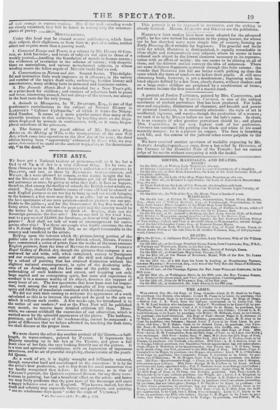FINE ARTS.
WE have got a National Gallery of pictures—such as it is; but a Gal ry of Na 'o t al Art is a very different thing. To be sure, as there chanced to be in Mr. ANGERSTEIN'S collection a few pictures by Hoeawrir, and two or three by 1.14.:VNDLIr5, G AIN SI:GROUCH, and WILKIE, !la .y were allowed to remain, as the nation bought the lot; and the Directors of the British Institution got rid of their pictures and patronage at once, by giving us what they had: it does so happen, therefore, that among the medley of schools the British is not wholly ex- cluded. Nay, should the lumber-rooms of some old lord be cleared of such English pictures as are too big to hang up and not worth bringing to the hammer, a few more may drop in as gifts: but as to collecting the beg specimens of our own painters—modern pictures are not pro. fitable to the jobbers; and for the Government to buy fine works of a living artist, when no one but the pour artist and the country would be the better for it, is ridiculous to think of. Resides, does not the Sovereign patronize the fine arts ? Do we not find in the Civil List, next to a payment of 12,000/. for furniture, an item of GS2/. for portrait. painter ? And shall we talk of want of encouragement for native genius after this? Yet there are people who fondly entertain the idea of a National Gallery of British Art, as an object honourable to the .country and beneficial to the artists. Relying upon the interest which the picture-loving _portion of the public take in the productions of the British school, Messrs. FINDEN have commenced a series of prints from the works of the most eminent English painters, from the time of REYNOLDS downwards. FirsosN's Royal Gallery of British Art, though the pictures that compose it are scattered far and wide, will, when completed, convey to 'foreigners • and our countrymen, some notion of the skill and talent displayed by a school of painting that has attained distinction without the slightest national encouragement, in spite of the deadening influ. ence of an Academy, and the low state of the public taste. An undertaking of such boldness and extent, and requiring not only large capital and an enterprising spirit, but taste and experience to -conduct it in a manner worthy of its object, deserves the support of .every lover of art. The few specimens that have been sent for inspec- tion, rank among the most perfect examples of line engraving, for spirit and fidelity of translation combined with finished execution.
We did not wait their coming to welcome the appearance of a work calculated as this is to interest the public and do good to the arts on which it reflects such credit. A few weeks ago, we introduced it to the notice of our readers ;• and as the First Part will be published next month, we reserve more detailed criticism till then. Mean- while, we cannot withhold the expression of our admiration, which is excited anew by the splendid appearance of the plates. The boldness, .precision, and brilliancy of the workmanship, cannot be surpassed: a point of difference that we before adverted to, touching the flesh tints, we shall discuss at the proper time.































 Previous page
Previous page